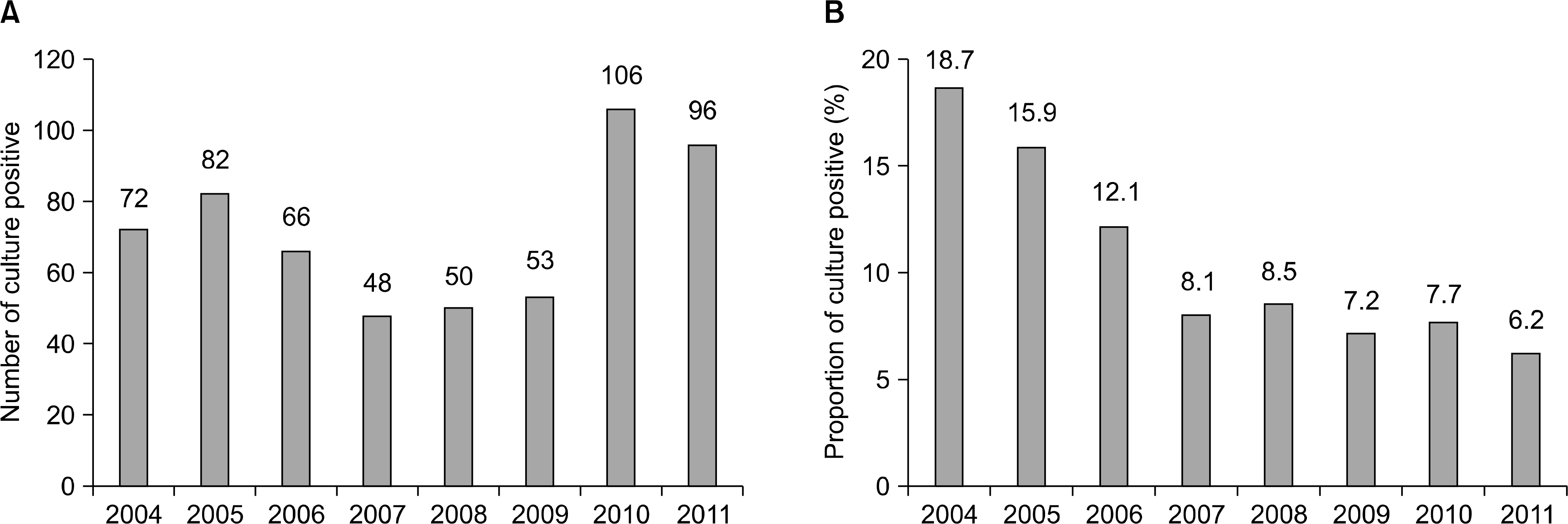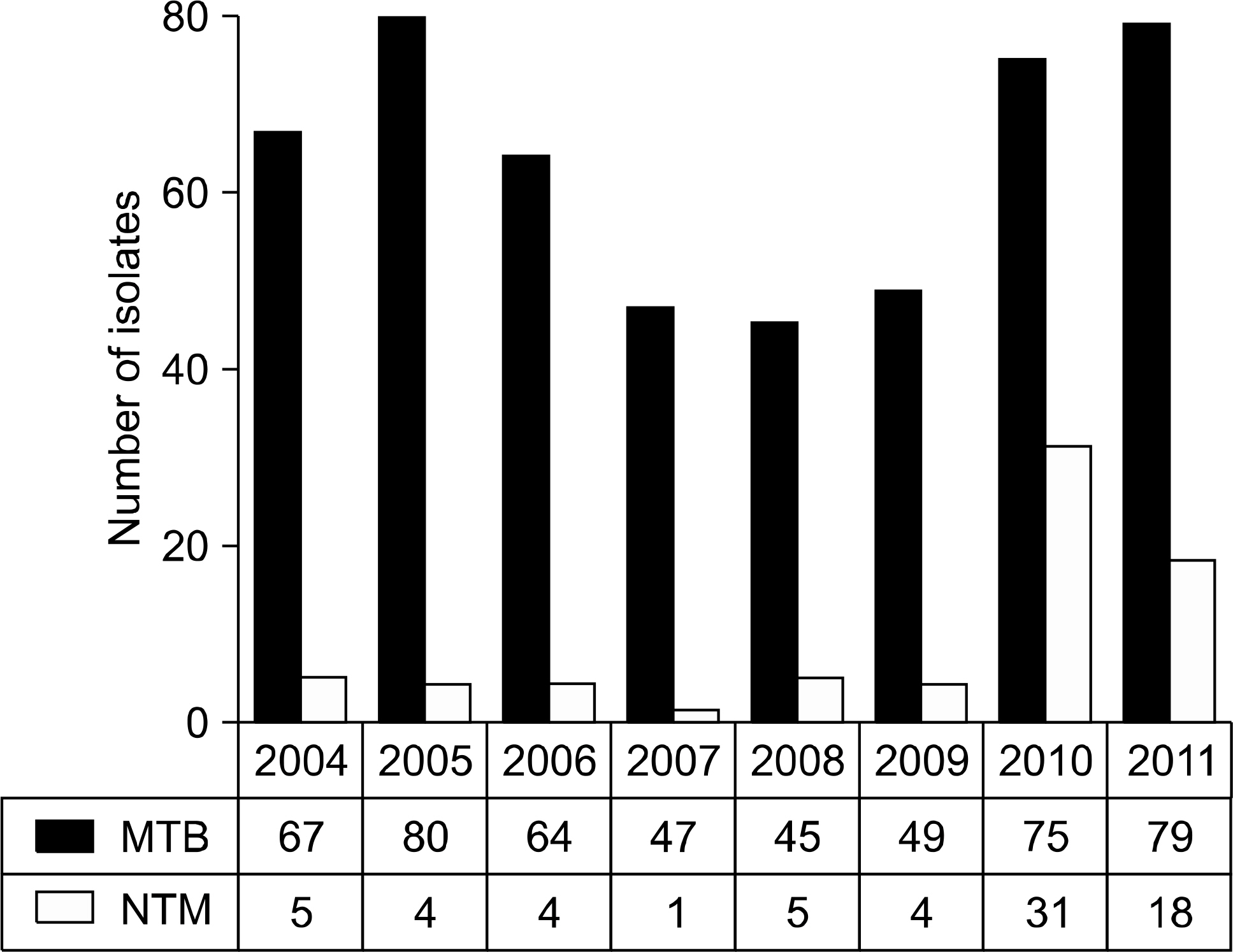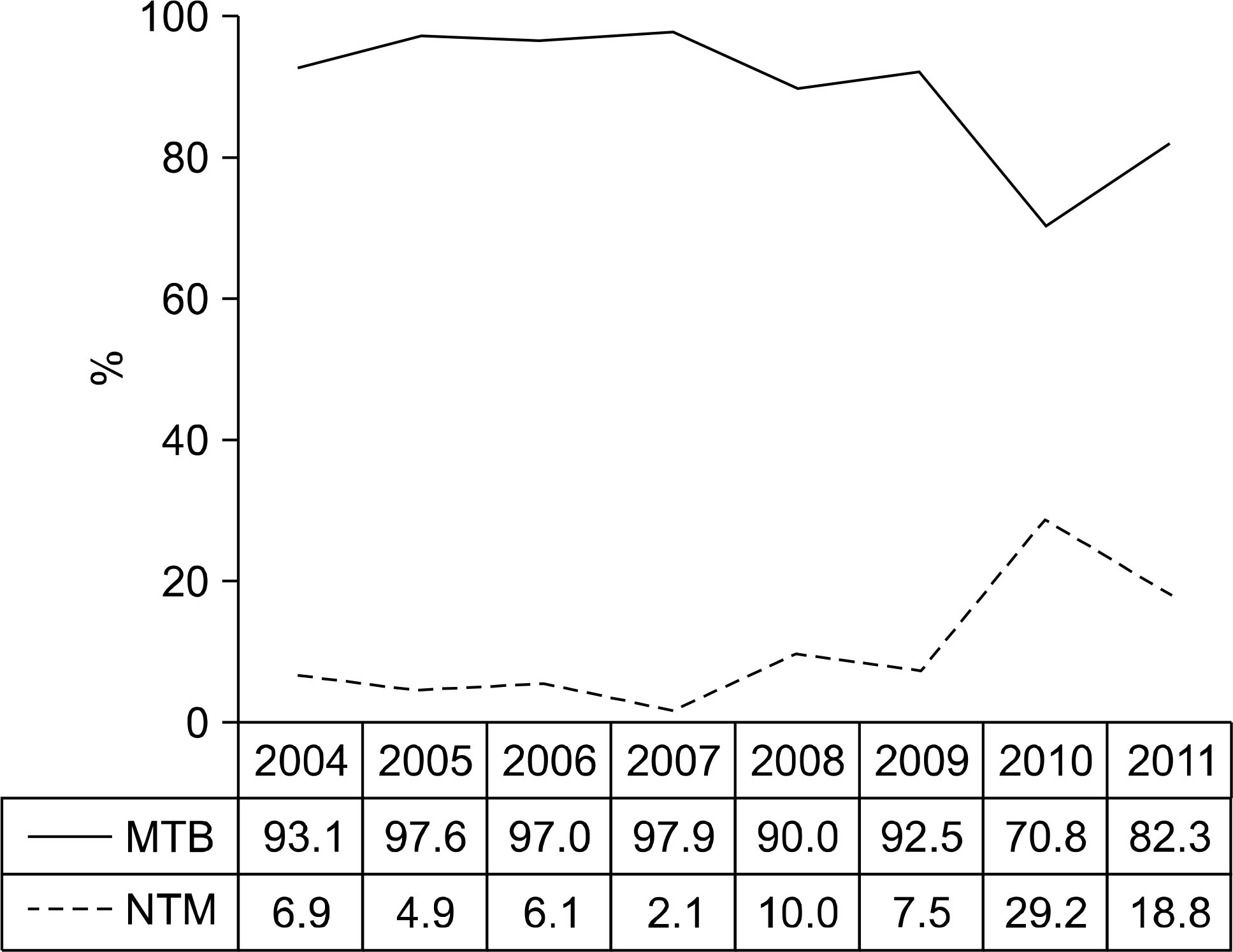Ann Clin Microbiol.
2013 Mar;16(1):13-18. 10.5145/ACM.2013.16.1.13.
The Increase of Nontuberculous Mycobacterial Isolation in the Specimens from Respiratory System in Jeju
- Affiliations
-
- 1Department of Internal Medicine, Jeju National University School of Medicine, Jeju, Korea. doc4u@hanmail.net
- KMID: 2169597
- DOI: http://doi.org/10.5145/ACM.2013.16.1.13
Abstract
- BACKGROUND
Pulmonary tuberculosis is an infectious disease of the lungs caused by Mycobacterium tuberculosis complex (MTB) designated by law in Korea, and accurate diagnosis and urgent treatment are necessary for the maintenance of public health. Recently, nontuberculous mycobacteria (NTM) have been more frequently isolated in respiratory system specimens, which were confused with MTB. We investigated whether the incidence of NTM isolation is increasing in Jeju, Korea.
METHODS
The results of microbacterial cultures of acid fast bacilli (AFB) from respiratory system specimens were collected at Jeju National University Hospital, Jeju, Korea from 2004 to 2011. The incidences of MTN or NTM isolation were analyzed.
RESULTS
A total of 15,484 AFB cultures were performed in 6,281 patients. In 2004, 365 AFB cultures were requested, and the number increased to 1,550 in 2011. However, the culture-positive rate decreased from 18.7% in 2004 to 6.19% in 2011. Among the 573 cultured specimens, 506 MTB (88.3%, mean age of 49.7, male 63.2%) and 72 NTM (12.6%, mean age of 65.8, male 50.0%) were identified. The proportions of NTM isolations were less than 10% until 2009, but increased to 30% after 2010 (P<0.001). M. avium complex (MAC) was the most frequently isolated NTM, followed by M. abscessus.
CONCLUSION
The proportion of NTM isolation is increasing. A clinical diagnosis of pulmonary tuberculosis based on respiratory system specimens should be made with caution, especially in cases of positive AFB smears.
MeSH Terms
Figure
Reference
-
1.Griffith DE., Aksamit T., Brown-Elliott BA., Catanzaro A., Daley C., Gordin F, et al. An official ATS/IDSA statement: diagnosis, treatment, and prevention of nontuberculous mycobacterial diseases. Am J Respir Crit Care Med. 2007. 175:367–416.
Article2.Koh WJ., Kwon OJ., Yu CM., Jeon KM., Suh GY., Chung MP, et al. Recovery rate of nontuberculous mycobacteria from acid-fast- bacilli smear-positive sputum specimens. Tuberc Respir Dis. 2003. 54:22–32.3.Park YS., Lee CH., Lee SM., Yang SC., Yoo CG., Kim YW, et al. Rapid increase of nontuberculous mycobacterial lung diseases at a tertiary referral hospital in South Korea. Int J Tuberc Lung Dis. 2010. 14:1069–71.4.Lee JK., Kwon HY., Kwon JK., Lee HJ., Lee DW., Lee YJ, et al. Recovery rate of nontuberculous mycobacteria and the clinical course of nontuberculous mycobacterial pulmonary disease at a secondary hospital. Tuberc Respir Dis. 2009. 67:199–204.
Article5.American Thocic Society. Diagnostic standards and classification of tuberculosis in adults and children. Am J Respir Crit Care Med. 2000. 161:1376–95.6.The Development of Korean Guidelines for Tuberculosis Korea Centers for Disease Control and Prevention. ed. Korean Guidelines for Tuberculosis. 1st ed. Seoul: The Korean Academy of Tuberculosis and Respiratory Diseases;2011.7.Daley CL., Griffith DE. Pulmonary nontuberculous mycobacterial infections. Int J Tuberc Lung Dis. 2010. 14:665–71.8.Glassroth J. Pulmonary disease due to nontuberculous mycobacteria. Chest. 2008. 133:243–51.
Article9.Bae E., Im JH., Kim SW., Yoon NS., Sung H., Kim MN, et al. Evaluation of combination of BACTEC mycobacteria growth indi-cator tube 960 system and Ogawa media for mycobacterial culture. Korean J Lab Med. 2008. 28:299–306.
Article10.Kivihya-Ndugga L., van Cleeff M., Juma E., Kimwomi J., Githui W., Oskam L, et al. Comparison of PCR with the routine procedure for diagnosis of tuberculosis in a population with high prevalences of tuberculosis and human immunodeficiency virus. J Clin Microbiol. 2004. 42:1012–5.
Article11.Centers for Disease Control and Prevention (CDC). Updated guidelines for the use of nucleic acid amplification tests in the diagnosis of tuberculosis. MMWR Morb Mortal Wkly Rep. 2009. 58:7–10.12.Mazurek GH., LoBue PA., Daley CL., Bernardo J., Lardizabal AA., Bishai WR, et al. Comparison of a whole-blood interferon gamma assay with tuberculin skin testing for detecting latent Mycobacterium tuberculosis infection. JAMA. 2001. 286:1740–7.13.Kobashi Y., Obase Y., Fukuda M., Yoshida K., Miyashita N., Oka M. Clinical reevaluation of the QuantiFERON TB-2G test as a diagnostic method for differentiating active tuberculosis from nontuberculous mycobacteriosis. Clin Infect Dis. 2006. 43:1540–6.
Article14.Lee JY., Choi HJ., Lee H., Joung EY., Huh JW., Oh YM, et al. Recovery rate and characteristics of nontuberculous mycobacterial isolates in a university hospital in Korea. Tuberc Respir Dis. 2005. 58:385–91.
Article15.Koh WJ., Kwon OJ., Lee KS. Diagnosis and treatment of nontuberculous mycobacterial pulmonary diseases: a Korean perspective. J Korean Med Sci. 2005. 20:913–25.
Article16.Choi SP., Lee BK., Min JH., Kim JH. Pathogenic classification and clinical characteristics of nontuberculous mycobacterial pulmonary disease in a national tuberculosis hospital. Tuberc Respir Dis. 2005. 59:606–12.
Article
- Full Text Links
- Actions
-
Cited
- CITED
-
- Close
- Share
- Similar articles
-
- Isolation of Nontuberculous Mycobacteria Using Polymerase Chain Reaction-Restriction Fragment Length Polymorphism
- Identification of Mycobacteria using High Performance Liquid Chromatography in Clinical Specimens
- Increasing Trend of Isolation of Non-Tuberculous Mycobacteria in a Tertiary University Hospital in South Korea
- Increasing burden of nontuberculous mycobacterial pulmonary disease
- Mycobacterium Szulgai Pulmonary Infection: Case Report of an Uncommon Pathogen in Korea






